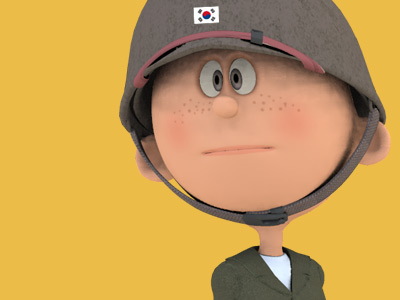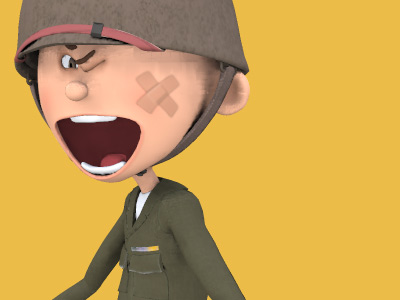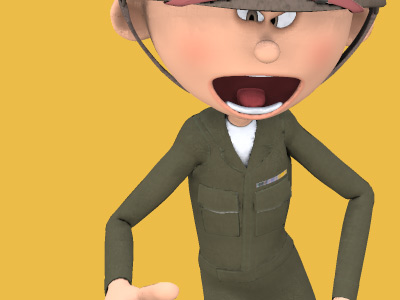Korean War 한국전쟁 (1950-1953)
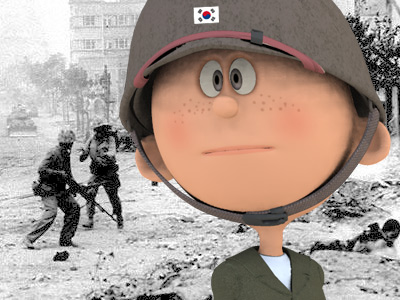
Characteristics of Korean War (1950-1953)
Casualties
According to the data from the U.S. Department of Defense, the United States suffered 33,686 battle deaths, along with 2,830 non-battle deaths, during the Korean War. U.S. battle deaths were 8,516 up to their first engagement with the Chinese on 1 November 1950. South Korea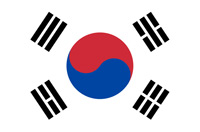 South Korea officially the Republic of Korea (ROK), is a country in East Asia, constituting the southern part of the Korean Peninsula and sharing a land border with North Korea. Since the 21st century, South Korea has been renowned for its globally influential pop culture, particularly in music (K-pop), TV dramas (K-dramas) and cinema, a phenomenon referred to as the Korean wave. reported some 373,599 civilian and 137,899 military deaths. Western sources estimate the PVA suffered about 400,000 killed and 486,000 wounded, while the KPA suffered 215,000 killed and 303,000 wounded.
South Korea officially the Republic of Korea (ROK), is a country in East Asia, constituting the southern part of the Korean Peninsula and sharing a land border with North Korea. Since the 21st century, South Korea has been renowned for its globally influential pop culture, particularly in music (K-pop), TV dramas (K-dramas) and cinema, a phenomenon referred to as the Korean wave. reported some 373,599 civilian and 137,899 military deaths. Western sources estimate the PVA suffered about 400,000 killed and 486,000 wounded, while the KPA suffered 215,000 killed and 303,000 wounded.
Data from official Chinese sources, on the other hand, reported that the PVA had suffered 114,000 battle deaths, 34,000 non-battle deaths, 340,000 wounded, 7,600 missing and during the war. 7,110 Chinese POWs were repatriated to China. Chinese sources also reported that North Korea North Korea, officially the Democratic People's Republic of Korea (DPRK) is a country in East Asia, in the northern part of the Korean Peninsula. The capital and largest city is Pyongyang. The Korean Demilitarized Zone marks the boundary between North Korea and South Korea. The legitimacy of this border is not accepted by either side, as both states claim to be the legitimate government of the entire peninsula. had suffered 290,000 casualties, 90,000 captured and a large number of civilian deaths.
North Korea, officially the Democratic People's Republic of Korea (DPRK) is a country in East Asia, in the northern part of the Korean Peninsula. The capital and largest city is Pyongyang. The Korean Demilitarized Zone marks the boundary between North Korea and South Korea. The legitimacy of this border is not accepted by either side, as both states claim to be the legitimate government of the entire peninsula. had suffered 290,000 casualties, 90,000 captured and a large number of civilian deaths.
The Chinese and North Koreans estimated that about 390,000 soldiers from the United States, 660,000 soldiers from South Korea and 29,000 other UN soldiers were "eliminated" from the battlefield. Recent scholarship has put the full battle death toll on all sides at just over 1.2 million.
Armored Warfare
The initial assault by North Korean KPA forces was aided by the use of Soviet T-34-85 tanks. A North Korean tank corps equipped with about 120 T-34s spearheaded the invasion. These drove against a ROK Army with few anti-tank weapons adequate to deal with the Soviet T-34s. Additional Soviet armor was added as the offensive progressed. The North Korean tanks had a good deal of early successes against South Korean infantry, elements of the 24th Infantry Division, and the United States The United States of America (U.S.A. or USA), commonly known as the United States (U.S. or US) or America, is a country in North America. It is the world's third-largest country by both land and total area. The United States shares land borders with Canada to its north and with Mexico to its south. The national capital is Washington, D.C., and the most populous city and financial center is New York City. built M24 Chaffee light tanks that they encountered. Interdiction by ground attack aircraft was the only means of slowing the advancing Korean armor. The tide turned in favour of the United Nations (UN)
The United States of America (U.S.A. or USA), commonly known as the United States (U.S. or US) or America, is a country in North America. It is the world's third-largest country by both land and total area. The United States shares land borders with Canada to its north and with Mexico to its south. The national capital is Washington, D.C., and the most populous city and financial center is New York City. built M24 Chaffee light tanks that they encountered. Interdiction by ground attack aircraft was the only means of slowing the advancing Korean armor. The tide turned in favour of the United Nations (UN)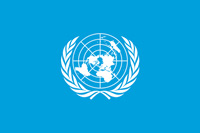 United Nations (UN) is an intergovernmental organization whose stated purposes are to maintain international peace and security, develop friendly relations among nations, achieve international cooperation, and be a centre for harmonizing the actions of nations. The UN was established after World War II with the aim of preventing future world wars, succeeding the League of Nations, which was characterized as ineffective. forces in August 1950 when the North Koreans suffered major tank losses during a series of battles in which the UN forces brought heavier equipment to bear, including M4A3 Sherman medium tanks backed by U.S. M26 heavy tanks, along with British Centurion, Churchill, and Cromwell tanks.
United Nations (UN) is an intergovernmental organization whose stated purposes are to maintain international peace and security, develop friendly relations among nations, achieve international cooperation, and be a centre for harmonizing the actions of nations. The UN was established after World War II with the aim of preventing future world wars, succeeding the League of Nations, which was characterized as ineffective. forces in August 1950 when the North Koreans suffered major tank losses during a series of battles in which the UN forces brought heavier equipment to bear, including M4A3 Sherman medium tanks backed by U.S. M26 heavy tanks, along with British Centurion, Churchill, and Cromwell tanks.
The U.S. landings at Inchon on 15 September cut off the North Korean supply lines, causing their armored forces and infantry to run out of fuel, ammunition, and other supplies. As a result, the North Koreans had to retreat, and many of the T-34s and heavy weapons had to be abandoned. By the time the North Koreans withdrew from the South, a total of 239 T-34s and 74 SU-76s had been lost. After November 1950, North Korean armor was rarely encountered.
Following the initial assault by the north, the Korean War saw limited use of the tank and featured no large-scale tank battles. The mountainous, forested terrain, especially in the Eastern Central Zone, was poor tank country, limiting their mobility. Through the last two years of the war in Korea, UN tanks served largely as infantry support and mobile artillery pieces.
Naval Warfare
Because neither Korea had a significant navy, the Korean War featured few naval battles. A skirmish between North Korea and the UN Command occurred on 2 July 1950; the U.S. Navy cruiser USS Juneau, the Royal Navy cruiser HMS Jamaica, and the frigate HMS Black Swan fought four North Korean torpedo boats and two mortar gunboats, and sank them. USS Juneau later sank several ammunition ships that had been present. The last sea battle of the Korean War occurred at Inchon, days before the Battle of Incheon; the ROK ship PC-703 sank a North Korean mine layer in the Battle of Haeju Island, near Inchon. Three other supply ships were sunk by PC-703 two days later in the Yellow Sea. Thereafter, vessels from the UN nations held undisputed control of the sea about Korea. The gun ships were used in shore bombardment, while the aircraft carriers provided air support to the ground forces.
During most of the war, the UN navies patrolled the west and east coasts of North Korea, sinking supply and ammunition ships and denying the North Koreans the ability to resupply from the sea. Aside from very occasional gunfire from North Korean shore batteries, the main threat to United States and UN navy ships was from magnetic mines. During the war, five U.S. Navy ships were lost to mines: two minesweepers, two minesweeper escorts, and one ocean tug. Mines and gunfire from North Korean coastal artillery damaged another 87 U.S. warships, resulting in slight to moderate damage.
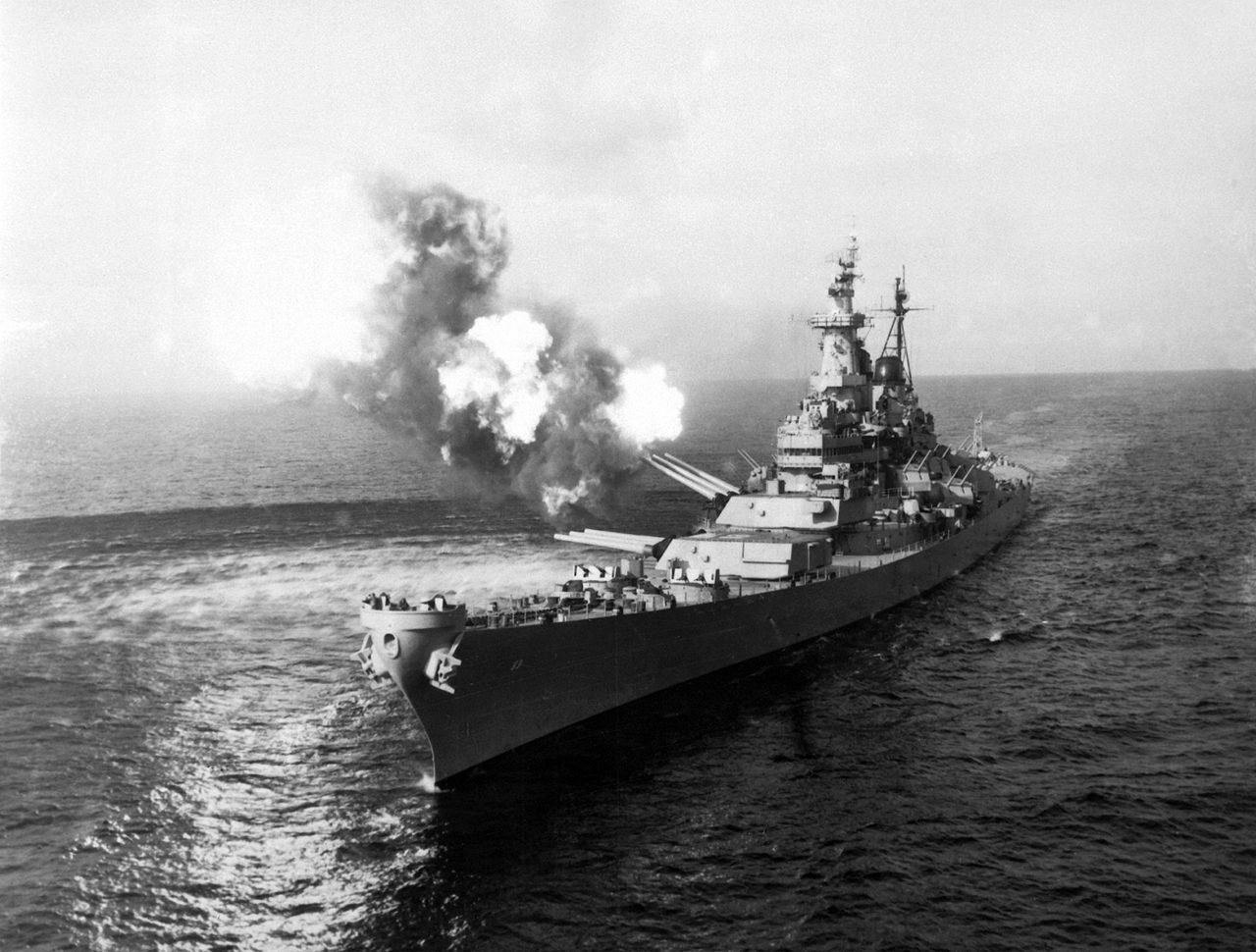
To disrupt North Korean communications, USS Missouri fires a salvo from its 16-inch guns at shore targets near Chongjin, North Korea, 21 October 1950

To disrupt North Korean communications, USS Missouri fires a salvo from its 16-inch guns at shore targets near Chongjin, North Korea, 21 October 1950
( Click image to enlarge)
Aerial Warfare
The Korean War was the first war in which jet aircraft played the central role in air combat. Once-formidable fighters such as the P-51 Mustang, F4U Corsair, and Hawker Sea Fury —all piston-engined, propeller-driven, and designed during World War II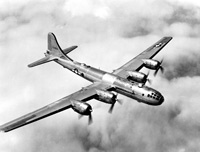 World War II or the Second World War, often abbreviated as WWII or WW2, was a world war that lasted from 1939 to 1945. It involved the vast majority of the world's countries—including all of the great powers—forming two opposing military alliances: the Allies and the Axis powers. World War II was a total war that directly involved more than 100 million personnel from more than 30 countries. World War II is generally considered to have begun on 1 September 1939, when Nazi Germany, under Adolf Hitler, invaded Poland. View World War II » - relinquished their air-superiority roles to a new generation of faster, jet-powered fighters arriving in the theater. For the initial months of the war, the P-80 Shooting Star, F9F Panther, Gloster Meteor and other jets under the UN flag dominated North Korea's prop-driven air force of Soviet Yakovlev Yak-9 and Lavochkin La-9s.
World War II or the Second World War, often abbreviated as WWII or WW2, was a world war that lasted from 1939 to 1945. It involved the vast majority of the world's countries—including all of the great powers—forming two opposing military alliances: the Allies and the Axis powers. World War II was a total war that directly involved more than 100 million personnel from more than 30 countries. World War II is generally considered to have begun on 1 September 1939, when Nazi Germany, under Adolf Hitler, invaded Poland. View World War II » - relinquished their air-superiority roles to a new generation of faster, jet-powered fighters arriving in the theater. For the initial months of the war, the P-80 Shooting Star, F9F Panther, Gloster Meteor and other jets under the UN flag dominated North Korea's prop-driven air force of Soviet Yakovlev Yak-9 and Lavochkin La-9s.
The Chinese intervention in late October 1950 bolstered the Korean People's Air Force (KPAF) of North Korea with the MiG-15, one of the world's most advanced jet fighters. The heavily armed MiGs were faster than first-generation UN jets and so could reach and destroy U.S. B-29 Superfortress bomber flights despite their fighter escorts. With increasing B-29 losses, the Air Force was forced to switch from a daylight bombing campaign to a safer but less accurate nighttime bombing of targets.
The USAF countered the MiG-15 by sending over three squadrons of its most capable fighter, the F-86 Sabre. These arrived in December 1950. The MiG was designed as a bomber interceptor. It had a very high service ceiling—50,000 feet (15,000 m) and carried very heavy weaponry: one 37 mm cannon and two 23 mm cannons. The F-86 had a ceiling of 42,000 feet (13,000 m) and were armed with six .50 caliber (12.7 mm) machine guns, which were range adjusted by radar gunsights. If coming in at higher altitude the advantage of engaging or not went to the MiG. Once in a level flight dogfight, both swept-wing designs attained comparable maximum speeds of around 660 mph (1,100 km/h). The MiG climbed faster, but the Sabre turned and dived better.
In summer and autumn 1951, the outnumbered Sabres of the USAF's 4th Fighter Interceptor Wing—only 44 at one point—continued seeking battle in MiG Alley, where the Yalu River marks the Chinese border, against Chinese and North Korean air forces capable of deploying some 500 aircraft. Following Colonel Harrison Thyng's communication with the Pentagon, the 51st Fighter-Interceptor Wing finally reinforced the beleaguered 4th Wing in December 1951; for the next year-and-a-half stretch of the war, aerial warfare continued.
Unlike the Vietnam War, in which the Soviet Union Soviet Union, officially the Union of Soviet Socialist Republics (USSR), was a transcontinental country that spanned much of Eurasia from 1922 to 1991. The Soviet Union fall process began with growing unrest in the Union's various constituent national republics developing into an incessant political and legislative conflict between them and the central government. Estonia was the first Soviet republic to declare state sovereignty inside the Union. only officially sent "advisers", in the Korean aerial war Soviet forces participated via the 64th Airborne Corps. Fearful of confronting the United States directly, the Soviet Union denied involvement of their personnel in anything other than an advisory role, but air combat quickly resulted in Soviet pilots dropping their code signals and speaking over the wireless in Russian. This known direct Soviet participation was a casus belli that the UN Command deliberately overlooked, lest the war for the Korean peninsula expand to include the Soviet Union, and potentially escalate into atomic warfare. 1,106 enemy airplanes were officially downed by the Soviet pilots, 52 of whom got ace status. The Soviet system of confirming air kills erred on the conservative side; the pilot's words had to be corroborated and enemy aircraft falling into the sea were not counted, the number might exceed 1,106.
Soviet Union, officially the Union of Soviet Socialist Republics (USSR), was a transcontinental country that spanned much of Eurasia from 1922 to 1991. The Soviet Union fall process began with growing unrest in the Union's various constituent national republics developing into an incessant political and legislative conflict between them and the central government. Estonia was the first Soviet republic to declare state sovereignty inside the Union. only officially sent "advisers", in the Korean aerial war Soviet forces participated via the 64th Airborne Corps. Fearful of confronting the United States directly, the Soviet Union denied involvement of their personnel in anything other than an advisory role, but air combat quickly resulted in Soviet pilots dropping their code signals and speaking over the wireless in Russian. This known direct Soviet participation was a casus belli that the UN Command deliberately overlooked, lest the war for the Korean peninsula expand to include the Soviet Union, and potentially escalate into atomic warfare. 1,106 enemy airplanes were officially downed by the Soviet pilots, 52 of whom got ace status. The Soviet system of confirming air kills erred on the conservative side; the pilot's words had to be corroborated and enemy aircraft falling into the sea were not counted, the number might exceed 1,106.
After the war, and to the present day, the USAF reports an F-86 Sabre kill ratio in excess of 10:1, with 792 MiG-15s and 108 other aircraft shot down by Sabres, and 78 Sabres lost to enemy fire. The Soviet Air Force reported some 1,100 air-to-air victories and 335 MiG combat losses, while China's People's Liberation Army Air Force (PLAAF) reported 231 combat losses, mostly MiG-15s, and 168 other aircraft lost. The KPAF reported no data, but the UN Command estimates some 200 KPAF aircraft lost in the war's first stage, and 70 additional aircraft after the Chinese intervention. The USAF disputes Soviet and Chinese claims of 650 and 211 downed F-86s, respectively. However, one unconfirmed source claims that the U.S. Air Force has more recently cited 230 losses out of 674 F-86s deployed to Korea.
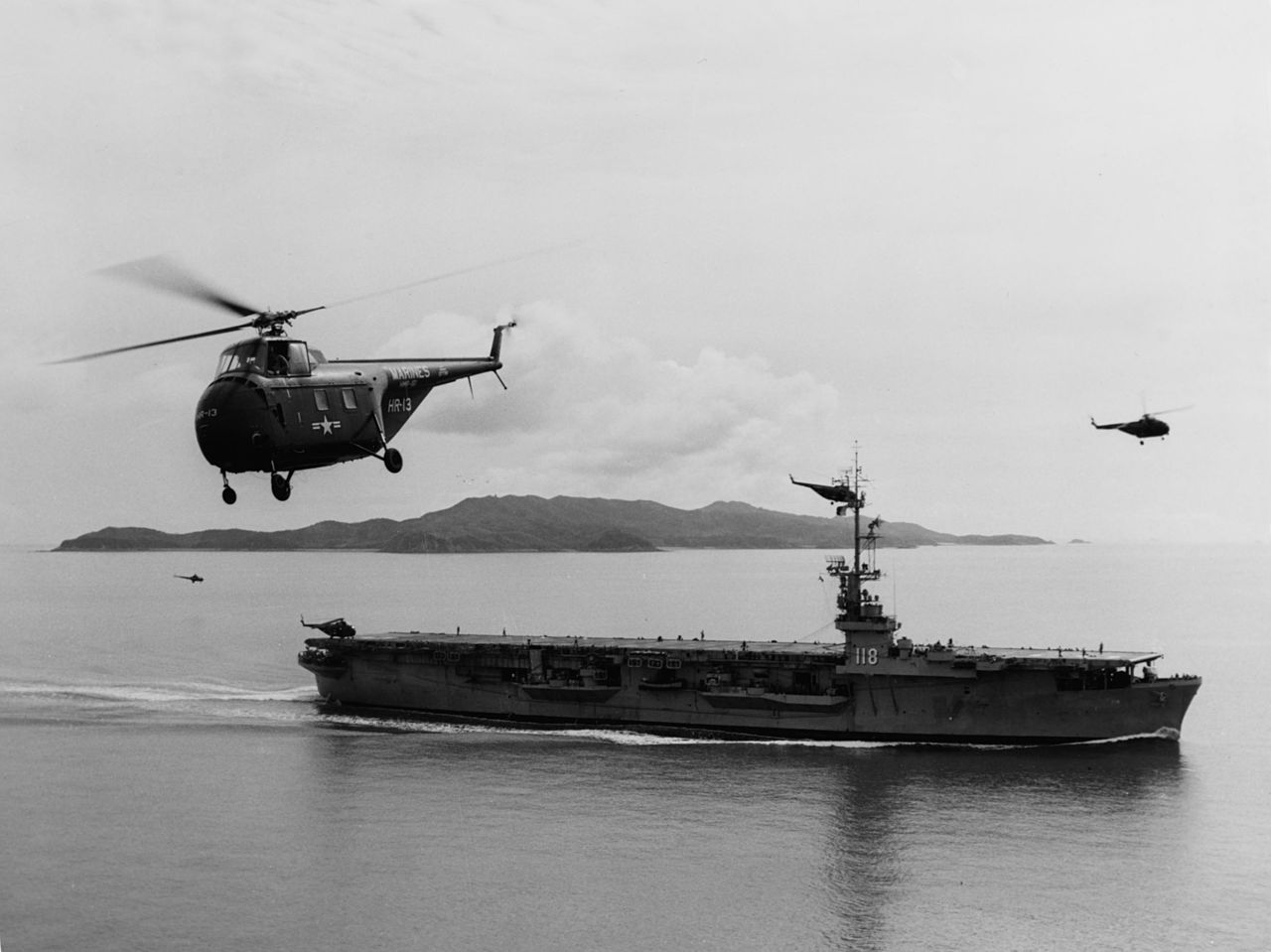
A US Navy Sikorsky HO4S flying near USS Sicily

A US Navy Sikorsky HO4S flying near USS Sicily
( Click image to enlarge)
The Korean War marked a major milestone not only for fixed-wing aircraft, but also for rotorcraft, featuring the first large-scale deployment of helicopters for medical evacuation (medevac). In 1944–1945, during the Second World War, the YR-4 helicopter saw limited ambulance duty, but in Korea, where rough terrain trumped the jeep as a speedy medevac vehicle, helicopters like the Sikorsky H-19 helped reduce fatal casualties to a dramatic degree when combined with complementary medical innovations such as Mobile Army Surgical Hospitals. The limitations of jet aircraft for close air support highlighted the helicopter's potential in the role, leading to development of the AH-1 Cobra and other helicopter gunships used in the Vietnam War (1965–75).
Bombing North Korea
The first major U.S. strategic bombing campaign against North Korea, begun in late July 1950, was conceived much along the lines of the major offensives of World War II. On 12 August 1950, the U.S. Air Force dropped 625 tons of bombs on North Korea; two weeks later, the daily tonnage increased to some 800 tons. After the Chinese intervention in November, General MacArthur ordered the increased bombing campaign on North Korea, including incendiary attacks against their arsenals and communications centers and especially against the "Korean end" of all the bridges across the Yalu River. As with the aerial bombing campaigns over Germany and Japan The Empire of Japan, also known as the Japanese Empire or Imperial Japan, was a historical nation-state and great power that existed from the Meiji Restoration in 1868 until the enactment of the post-World War II 1947 constitution and subsequent formation of modern Japan. Economic and political turmoil in the 1920s led to the rise of militarism, nationalism and totalitarianism eventually culminating in Japan's membership in the Axis alliance. in World War II, the nominal objective of the U.S. Air Force was to destroy North Korea's war infrastructure and shatter their morale. After MacArthur was removed as Supreme Commander in Korea in April 1951, his successors continued this policy and eventually extended it to all of North Korea. Overall, the U.S. dropped 635,000 tons of bombs—including 32,557 tons of napalm—on Korea, more than they did during the whole Pacific campaign of World War II.
The Empire of Japan, also known as the Japanese Empire or Imperial Japan, was a historical nation-state and great power that existed from the Meiji Restoration in 1868 until the enactment of the post-World War II 1947 constitution and subsequent formation of modern Japan. Economic and political turmoil in the 1920s led to the rise of militarism, nationalism and totalitarianism eventually culminating in Japan's membership in the Axis alliance. in World War II, the nominal objective of the U.S. Air Force was to destroy North Korea's war infrastructure and shatter their morale. After MacArthur was removed as Supreme Commander in Korea in April 1951, his successors continued this policy and eventually extended it to all of North Korea. Overall, the U.S. dropped 635,000 tons of bombs—including 32,557 tons of napalm—on Korea, more than they did during the whole Pacific campaign of World War II.
As a result, almost every substantial building in North Korea was destroyed. The war's highest-ranking American POW, U.S. Major General William F. Dean, reported that most of the North Korean cities and villages he saw were either rubble or snow-covered wastelands. North Korean factories, schools, hospitals, and government offices were forced to move underground, and air defenses were "virtually non-existent." In November 1950, the North Korean leadership instructed their population to build dugouts and mud huts, as well as dig underground tunnels, in order to solve the acute housing problem. U.S. Air Force General Curtis LeMay commented, "we went over there and fought the war and eventually burned down every town in North Korea anyway, some way or another, and some in South Korea, too." Pyongyang, which saw 75 percent of its area destroyed, was so devastated that bombing was halted as there were no longer any worthy targets. On 28 November, Bomber Command reported on the campaign's progress: 95 percent of Manpojin was destroyed, along with 90 percent of Hoeryong, Namsi and Koindong, 85 percent of Chosan, 75 percent of both Sakchu and Huichon, and 20 percent of Uiju. According to USAF damage assessments, "eighteen of twenty-two major cities in North Korea had been at least half obliterated." By the end of the campaign, US bombers had difficulty in finding targets and were reduced to bombing footbridges or jettisoning their bombs into the sea.
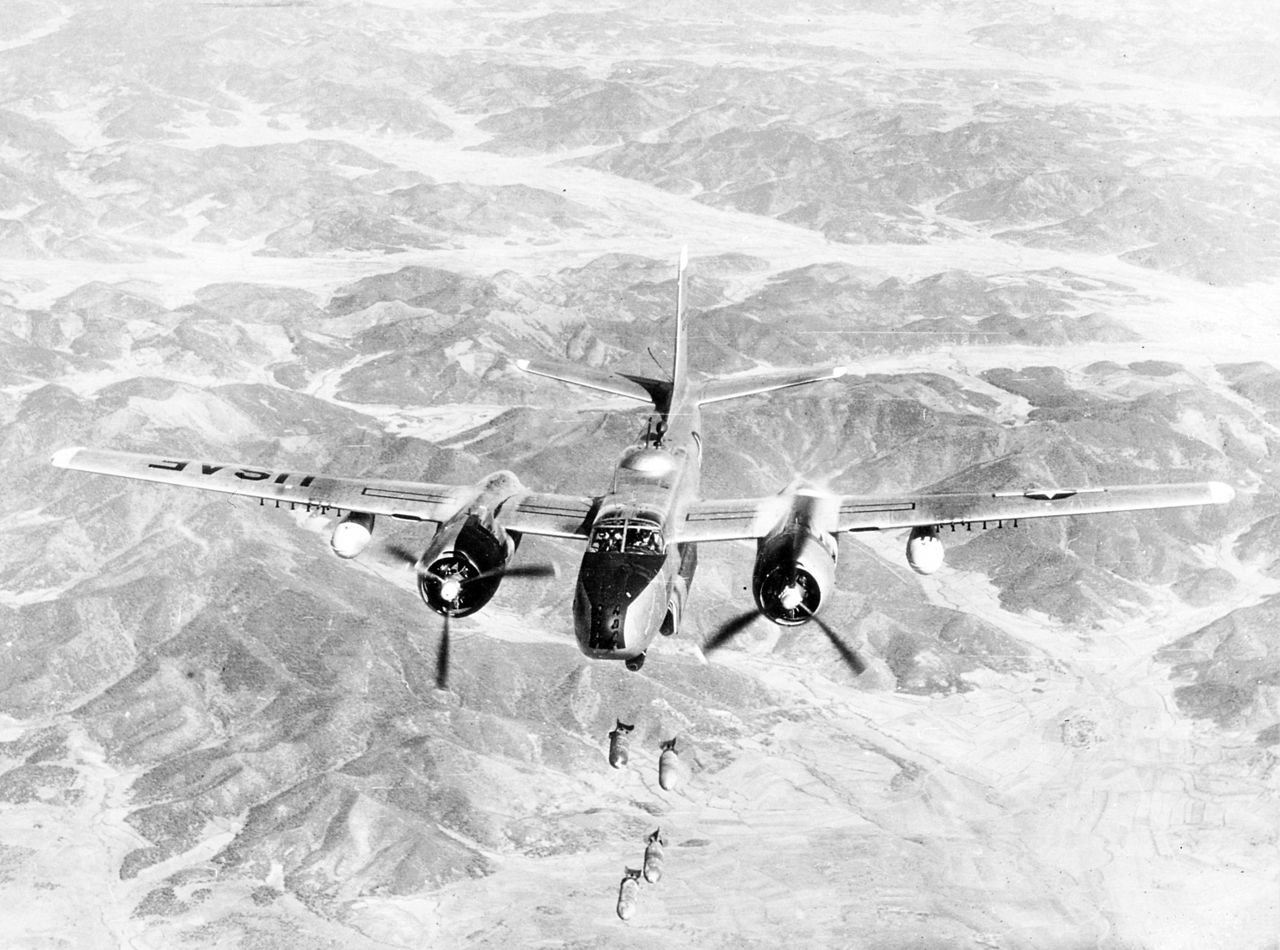
A USAF Douglas B-26B Invader of the 452nd Bombardment Wing bombing a target in North Korea, 29 May 1951

A USAF Douglas B-26B Invader of the 452nd Bombardment Wing bombing a target in North Korea, 29 May 1951
( Click image to enlarge)
As well as conventional bombing, the Communist side claimed that the U.S. had used biological weapons. These claims have been disputed; Conrad Crane asserts that while the U.S. worked towards developing chemical and biological weapons, the American military "possessed neither the ability, nor the will", to use them in combat.
HISTORY
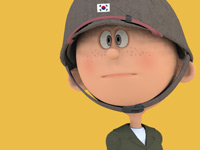
RESOURCES
This article uses material from the Wikipedia article "Korean War", which is released under the Creative Commons Attribution-Share-Alike License 3.0.
© Stories Preschool. All Rights Reserved.
